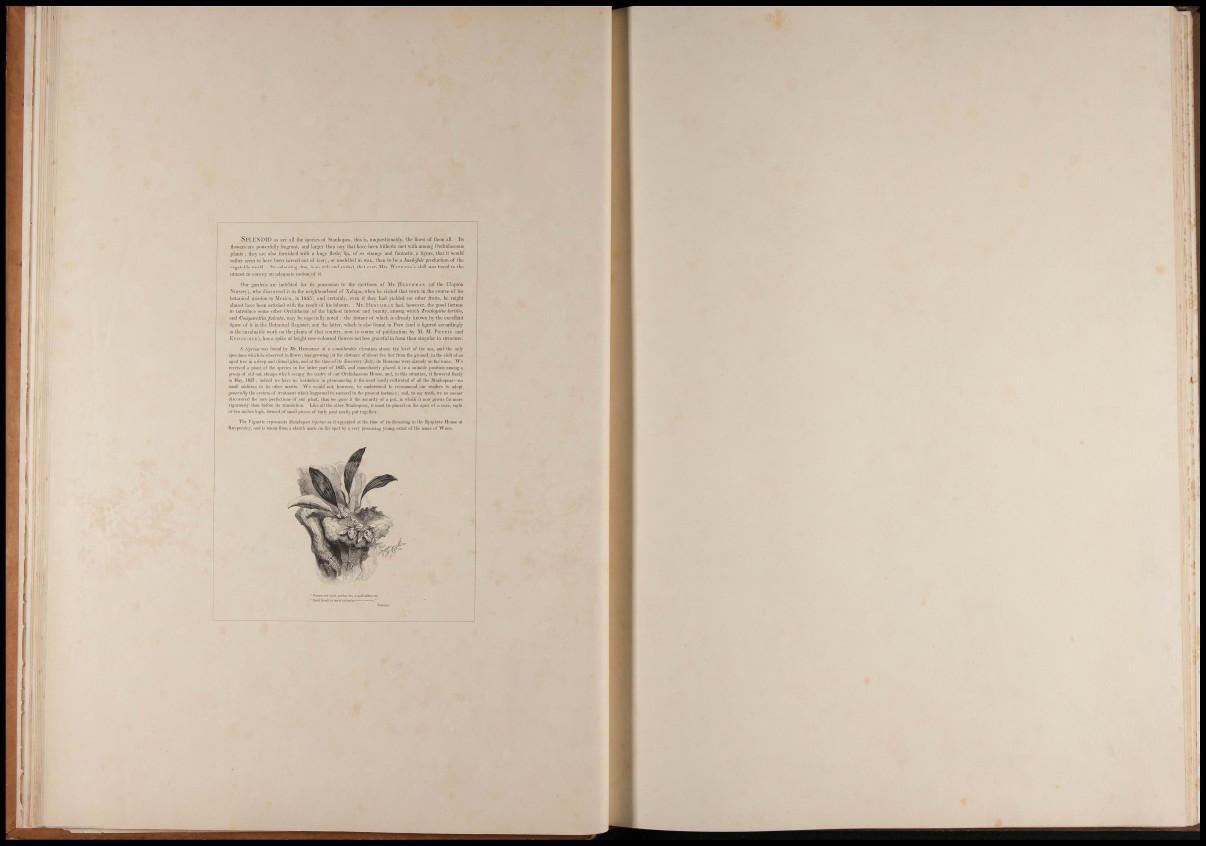
r
f •
S P L E N D I D US are all Oie spedcs of SUinliopea, lliis is, unquestionably, (he finest of tliem all. Its
iloA\-cvs are po^verfullj' fnigraiit, iuicl larger than any that have been liithcrto met witli among Orchidaceous
plants ; they are also funiishecl with a huge ilcshv lip, of so strange and fantastic a figure, that i( would
rather seem to have been canned out of ivory, or modelled in wax, thai) lo be a honii-Jide production of the
vegetable world. Its colouring, too, is so rich and varied, tlnit even Mrs. ^VITHEUS'S skill was taxed to tlie
utmost to convey an adequate notion of it.
Our gsirdens lu-e indebted for its possession to the exertions of Mr. HENCHMAN (of the Clapton
Nursery), who discovered it in tiic neighbourhood of Xalapa, when he \isited that to>\-n in the course of his
botimical mission to Mexico, in 1S35; and certainly, even if they had yielded no other fruits, he might
almost have been satisfied with tlie result of Ids labours. Mr. IIENCHMAS had, however, Uic good fortune
to introduce some other Orchidacc;i: of the highest interest and beauty, among which Trichopilia ior/ifis,
and Compurctlia falcata, may be especially noted : the fonner of which is already known by tlie excellent
figure of it in llu- Botaniciil l^egister, and the latter, which is also found in Peni (and is figured accordingly
in the invaluable work on the plants of that countrv-, now in coui-se of publication by iM. M. P<EFI>io and
E x nMcnF.n) , has a spike of briglit rosc-coloured tlowei"s not less graceful in form than singular in structure.
S. iigrivu was found liy ilr. IlETiCHMAN at a cousitlerable elevation above tlic level of the sea, and the onir
specimen \rhicli lie observed in flower, was growing (at the distance of about five feel from the ^ouud) in Uie cleft of nn
aged tree iii n deep aiul dismal glen, and at the time of its discovery (July) its tjlossoms were already on the wane. We
received a pliuit of the species in tlie latter part of 1835, ¡md immediately placed it in a suitable position among a
group of old oak stumps wliich occupy the centre of our Orchidaceous House, and, ia this situation, it Qowered freely
in May, 18.37: indeed we have no licsitation in pronouncing it tJie most easily cultivated of all the Stanliopeas—no
sma]l addition to its other merits. We would not, however, be understood to recommend our readers to adopt
generally the system of treatment which happened to succeed in tlie present instance; and, to say trutl», we no sooner
discovered tiie rare perfections of our piiuit, than we gave it tlie security of a pot, in which it now grows far more
vigorously than bctbre its translation. Like all the other Stanhopeas, it must be placed on the apex of a cone, eiglit
or ten inches liigli, forjne<l of small pieces of turfy peat neatly put together.
The Vignette represents Stanhopeu lujrina as it appeareti at the time of its flowering in the Epiphyte House at
Knypersley, and is taken from a sketch made on the spot by a very promising young artist of the name of WOOD.
" -Somen crit [utjui, Ico. li qiiid udlmc at,
•• CJuoil fremil ill icrm vidcnlior
J I
I ; 1